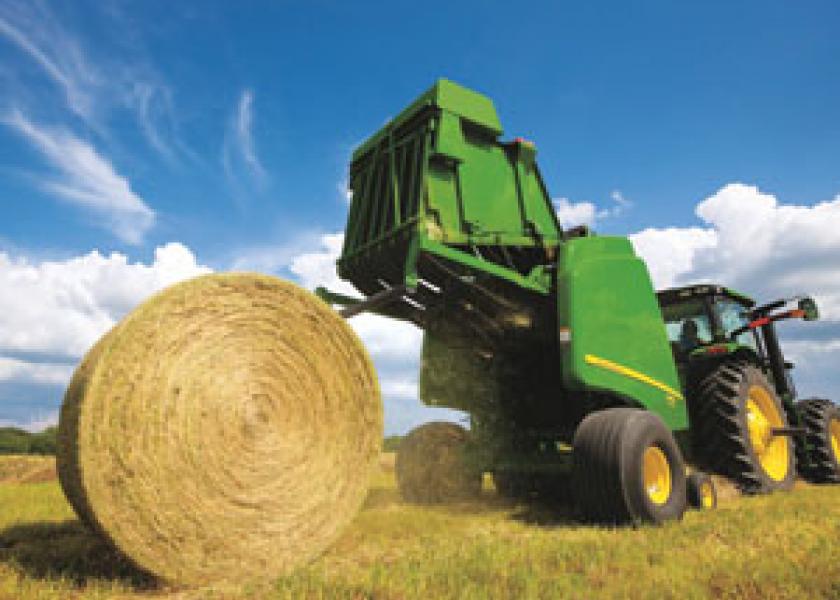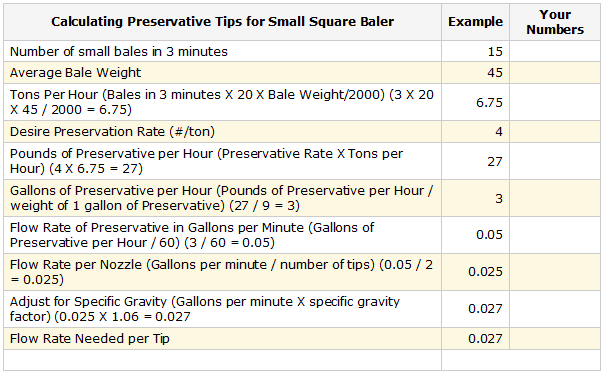Value of Baler Preservative Applicators

By Andrew Frankenfield, Penn State
Preservative applicators likely worth the effort and expense to save the harvest.
Anyone that bales dry hay has had to chase a field of hay in before the rain comes. This happened last week to many people in my area. Many times the hay is almost fit to bale but it is a little tough and you bale it and hope it doesn’t mold. These are the times you think, if I only had a preservative applicator on the baler I could bale this and shouldn’t have any problems. Then you think, they are too expensive for me I only bale a couple thousand small square bales a year. Think again!
You can buy a basic 25 gallon baler liquid applicator for less than $400. It is not complicated; it is a small electric sprayer that you mount on the baler. The next thing you would probably want is a baler mounted moisture tester so you can see the moisture of the hay as you bale. They can be purchased for $350-$500. So for about $800 you can outfit your baler with the ability to apply a hay preservative when conditions are not perfect for baling, but be able to get the hay off the field before the rain destroys the quality.
Of course if you want all the bells and whistles you can spend a few thousand dollars or more to get fully automatic controls. These systems have a monitor that regulates the flow of the preservative depending on the moisture content of the hay also the applicator turns off and on when hay is flowing thru the baler pick up with the used of an electric eye. The choice is yours. But think of the value of 5 acres of hay that you don’t get baled due to rain. That could have been worth $2,500 ($250 a ton x 2 tons per acre x 5 acres), now it is only worth maybe $125 a ton and valued at $1,250. That $1,250 lost could have paid for the applicator, moisture tester and preservative and you would still have money left in your pocket.
How much will it cost to apply the preservative to small square bales?
You can buy various types of preservatives in multiple unit sizes. One product for example, if you buy a 50 gallon drum (450 pounds) it costs about $650 or $1.44 per pound. If you buy a 200 gallon tote (1,800 pounds) it costs about $2,500 or $1.39 per pound.
 |
How do you calculate how much preservative to apply?
It is like calibrating a sprayer, but instead of gallons per acre you need to calculate pounds per ton. First you need to figure out how many tons per hour of hay you bale. Count the number of small square bales you make in three minutes. Let’s say it is 15 bales. Then weigh several of those bales to get an average weight. Let’s say they are 45 pounds. If you bale 15 bales in 3 minutes then in an hour of continuous baling you will bale 300 bales with an average weight of 45 pounds. 45 x 300 = 13,500 pounds per hour or 6.75 tons/hour. If you are trying to apply 4 pounds of preservative per ton you will need (6.75 x 4) 27 pounds per hour. If the preservative weighs 9 pounds per gallon that is 3 gallons per hour (27/9=3) or 0.05 gallons per minute (3/60=0.05). Since the applicator has 2 spray tips you want to get a tip that applies 0.025 gallons per minute since you will be using 2 tips at the pickup head of the baler.
Remember to take into account the specific gravity since the preservative is slightly heavier than water. In my example the specific gravity factor is 1.06 (0.0025 x 1.06=0.027 gallons per minute). I would recommend having another pair of tips that applies 0.05 gallons per minute each so you can put them in if the hay moisture is above 22% and you need to double your preservative rate to 8 pounds per ton.
 |
I know it is more money to spend, but it may be an investment that pays for itself the first year you install it on the baler. This is something you could do this week, since it doesn’t look like hay making weather!
For More Information
Stay up-to-date, read the latest dairy news and beef news.







